
Concept explainers
Top ten video games: According to Wikipedia, the following are the top ten selling video games of all time.
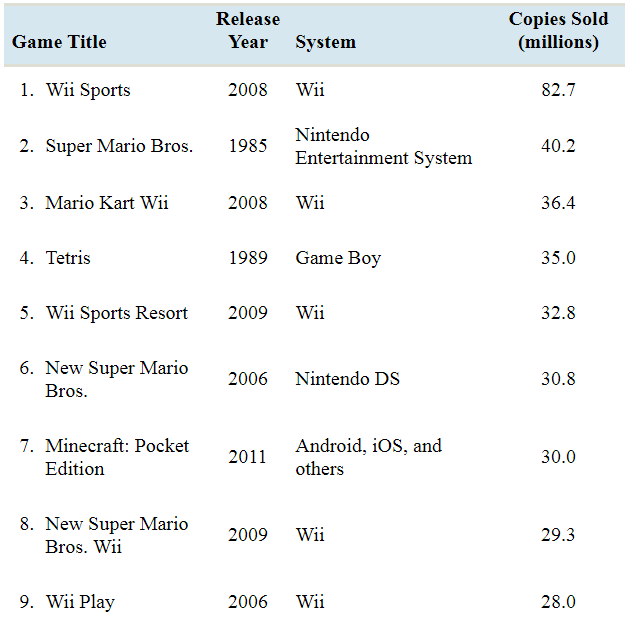

- Which of the columns represent qualitative variables?
- Which of the columns represent quantitative variables?
- Which of the columns represent nominal variables?
- Which of the columns represent ordinal variables?
a.
To identify:the columns that represent qualitative variables.
Answer to Problem 47E
The columns Game Title and System represent qualitative variables.
Explanation of Solution
Given information:
| Game Title | Release Year | System | Copies Sold (millions) |
| 1. 1. Wii Sports | 2008 | Wii | 82.7 |
| 2. 2. Super Mario Bros. | 1985 | Nintendo Entertainment System | 40.2 |
| 3. 3. Mario Kart Wii | 2008 | Wii | 36.4 |
| 4. 4. Tetris | 1989 | Game Boy | 35.0 |
| 5. 5. Wii Sports Resort | 2009 | Wii | 32.8 |
| 6. 6. New Super Mario Bros | 2006 | Nintendo DS | 30.8 |
| 7. 7. Minecraft: Pocket Edition | 2011 | Android, iOS, and others | 30.0 |
| 8. 8. New Super Mario Bros. Wii | 2009 | Wii | 29.3 |
| 9. 9. Wii Play | 2006 | Wii | 28.0 |
| 10. 10. Kinect Adventures | 2010 | Xbox 360 | 24.0 |
Concept Involved:
There are various methods of collecting information by sampling. Once the information has been collected, the collection is called a data set. Variables can be divided into two types: qualitative and quantitative. Qualitative variables are also called categorical variable, classify individuals into categories. Quantitative variables are numerical and tell how much of something there is.
Qualitative variables come in two types: ordinal variables and nominal variables.
Ordinal variables are qualitative variables whose categories have a natural ordering.
Nominal variables are qualitative variables whose categories have no natural ordering.
Quantitative variables can be either discrete or continuous.
Discrete variables are those whose possible values can be listed. Often, discrete variables result from counting something, so the possible values of the variable are 0, 1, 2 and so forth.
Continuous variables can, in principle, take on any value within some interval.
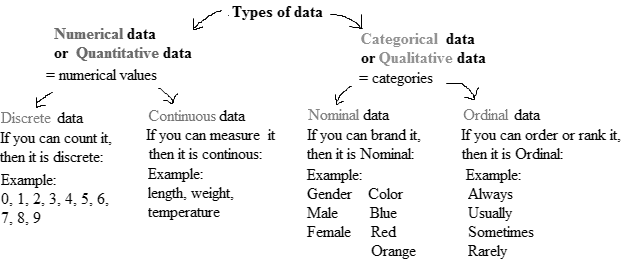
The variable which classifies individuals into categories is called qualitative variable, and the variable which provide information about quantity or number of something is quantitative variable. The Game Title and System classifies the top ten selling video games of all time.
Therefore, the columns Game Title and System represent qualitative variables.
b.
To identify:the columns that represent quantitative variables.
Answer to Problem 47E
The columns Copies sold (millions) represent quantitative variables.
Explanation of Solution
Given information:
| Game Title | Release Year | System | Copies Sold (millions) |
| 1. Wii Sports | 2008 | Wii | 82.7 |
| 2. Super Mario Bros. | 1985 | Nintendo Entertainment System | 40.2 |
| 3. Mario Kart Wii | 2008 | Wii | 36.4 |
| 4. Tetris | 1989 | Game Boy | 35.0 |
| 5. Wii Sports Resort | 2009 | Wii | 32.8 |
| 6. New Super Mario Bros | 2006 | Nintendo DS | 30.8 |
| 7. Minecraft: Pocket Edition | 2011 | Android, iOS, and others | 30.0 |
| 8. New Super Mario Bros. Wii | 2009 | Wii | 29.3 |
| 9. Wii Play | 2006 | Wii | 28.0 |
| 10. Kinect Adventures | 2010 | Xbox 360 | 24.0 |
Concept Involved:
There are various methods of collecting information by sampling. Once the information has been collected, the collection is called a data set. Variables can be divided into two types: qualitative and quantitative. Qualitative variables are also called categorical variable, classify individuals into categories. Quantitative variables are numerical and tell how much of something there is.
Qualitative variables come in two types: ordinal variables and nominal variables.
Ordinal variables are qualitative variables whose categories have a natural ordering.
Nominal variables are qualitative variables whose categories have no natural ordering.
Quantitative variables can be either discrete or continuous.
Discrete variables are those whose possible values can be listed. Often, discrete variables result from counting something, so the possible values of the variable are 0, 1, 2 and so forth.
Continuous variables can, in principle, take on any value within some interval.
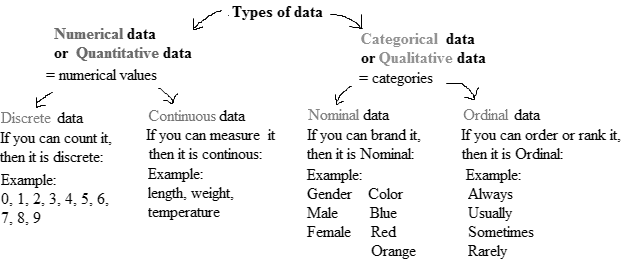
The variable which classifies individuals into categories is called qualitative variable, and the variable which provide information about quantity or number of something is quantitative variable. The column copies sold (in millions) represent how many of something is there.
Therefore, it represents quantitative variable.
c.
To identify:the columns that represent nominal variables.
Answer to Problem 47E
The columns System represent nominal variables.
Explanation of Solution
Given information:
| Game Title | Release Year | System | Copies Sold (millions) |
| 1. Wii Sports | 2008 | Wii | 82.7 |
| 2. Super Mario Bros. | 1985 | Nintendo Entertainment System | 40.2 |
| 3. Mario Kart Wii | 2008 | Wii | 36.4 |
| 4. Tetris | 1989 | Game Boy | 35.0 |
| 5. Wii Sports Resort | 2009 | Wii | 32.8 |
| 6. New Super Mario Bros | 2006 | Nintendo DS | 30.8 |
| 7. Minecraft: Pocket Edition | 2011 | Android, iOS, and others | 30.0 |
| 8. New Super Mario Bros. Wii | 2009 | Wii | 29.3 |
| 9. Wii Play | 2006 | Wii | 28.0 |
| 10. Kinect Adventures | 2010 | Xbox 360 | 24.0 |
Concept Involved:
There are various methods of collecting information by sampling. Once the information has been collected, the collection is called a data set. Variables can be divided into two types: qualitative and quantitative. Qualitative variables are also called categorical variable, classify individuals into categories. Quantitative variables are numerical and tell how much of something there is.
Qualitative variables come in two types: ordinal variables and nominal variables.
Ordinal variables are qualitative variables whose categories have a natural ordering.
Nominal variables are qualitative variables whose categories have no natural ordering.
Quantitative variables can be either discrete or continuous.
Discrete variables are those whose possible values can be listed. Often, discrete variables result from counting something, so the possible values of the variable are 0, 1, 2 and so forth.
Continuous variables can, in principle, take on any value within some interval.
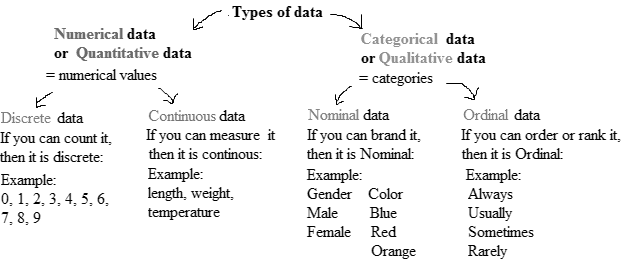
The values are classified into categories in a nominal variable, but no natural ordering is there in categories, whereas, the values are also classified into categories in an ordinary variable but a natural ordering is there in categories.
Therefore, the columns system represents nominal variables.
d.
To identify:the columns that represent ordinal variables.
Answer to Problem 47E
The columns Game Title represent ordinal variables.
Explanation of Solution
Given information:
| Game Title | Release Year | System | Copies Sold (millions) |
| 1. Wii Sports | 2008 | Wii | 82.7 |
| 2. Super Mario Bros. | 1985 | Nintendo Entertainment System | 40.2 |
| 3. Mario Kart Wii | 2008 | Wii | 36.4 |
| 4. Tetris | 1989 | Game Boy | 35.0 |
| 5. Wii Sports Resort | 2009 | Wii | 32.8 |
| 6. New Super Mario Bros | 2006 | Nintendo DS | 30.8 |
| 7. Minecraft: Pocket Edition | 2011 | Android, iOS, and others | 30.0 |
| 8. New Super Mario Bros. Wii | 2009 | Wii | 29.3 |
| 9. Wii Play | 2006 | Wii | 28.0 |
| 10. Kinect Adventures | 2010 | Xbox 360 | 24.0 |
Concept Involved:
There are various methods of collecting information by sampling. Once the information has been collected, the collection is called a data set. Variables can be divided into two types: qualitative and quantitative. Qualitative variables are also called categorical variable, classify individuals into categories. Quantitative variables are numerical and tell how much of something there is.
Qualitative variables come in two types: ordinal variables and nominal variables.
Ordinal variables are qualitative variables whose categories have a natural ordering.
Nominal variables are qualitative variables whose categories have no natural ordering.
Quantitative variables can be either discrete or continuous.
Discrete variables are those whose possible values can be listed. Often, discrete variables result from counting something, so the possible values of the variable are 0, 1, 2 and so forth.
Continuous variables can, in principle, take on any value within some interval.
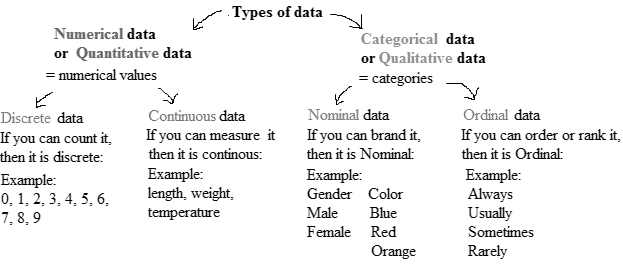
The values are classified into categories in a nominal variable, but no natural ordering is there in categories, whereas, the values are also classified into categories in an ordinary variable but a natural ordering is there in categories.The variable game title classifies the top ten selling video games.
Therefore, column Game Title represents ordinal variables.
Want to see more full solutions like this?
Chapter 1 Solutions
ELEMENTARY STATISTICS-ALEKS ACCESS CODE
- 1. (i) Explain the difference in application between the Mann-Whitney U test and the Wilcoxon Signed-Rank test, i.e. in which scenarios would each test be used? (ii) What is the main procedure underlying these nonparametric tests? [3 Marks]arrow_forwardYou may need to use the appropriate appendix table or technology to answer this question. You are given the following information obtained from a random sample of 4 observations. 24 48 31 57 You want to determine whether or not the mean of the population from which this sample was taken is significantly different from 49. (Assume the population is normally distributed.) (a) State the null and the alternative hypotheses. (Enter != for ≠ as needed.) H0: Ha: (b) Determine the test statistic. (Round your answer to three decimal places.) (c) Determine the p-value, and at the 5% level of significance, test to determine whether or not the mean of the population is significantly different from 49. Find the p-value. (Round your answer to four decimal places.) p-value = State your conclusion. Reject H0. There is insufficient evidence to conclude that the mean of the population is different from 49.Do not reject H0. There is sufficient evidence to conclude that the…arrow_forward65% of all violent felons in the prison system are repeat offenders. If 43 violent felons are randomly selected, find the probability that a. Exactly 28 of them are repeat offenders. b. At most 28 of them are repeat offenders. c. At least 28 of them are repeat offenders. d. Between 22 and 26 (including 22 and 26) of them are repeat offenders.arrow_forward
- 08:34 ◄ Classroom 07:59 Probs. 5-32/33 D ا. 89 5-34. Determine the horizontal and vertical components of reaction at the pin A and the normal force at the smooth peg B on the member. A 0,4 m 0.4 m Prob. 5-34 F=600 N fr th ar 0. 163586 5-37. The wooden plank resting between the buildings deflects slightly when it supports the 50-kg boy. This deflection causes a triangular distribution of load at its ends. having maximum intensities of w, and wg. Determine w and wg. each measured in N/m. when the boy is standing 3 m from one end as shown. Neglect the mass of the plank. 0.45 m 3 marrow_forwardExamine the Variables: Carefully review and note the names of all variables in the dataset. Examples of these variables include: Mileage (mpg) Number of Cylinders (cyl) Displacement (disp) Horsepower (hp) Research: Google to understand these variables. Statistical Analysis: Select mpg variable, and perform the following statistical tests. Once you are done with these tests using mpg variable, repeat the same with hp Mean Median First Quartile (Q1) Second Quartile (Q2) Third Quartile (Q3) Fourth Quartile (Q4) 10th Percentile 70th Percentile Skewness Kurtosis Document Your Results: In RStudio: Before running each statistical test, provide a heading in the format shown at the bottom. “# Mean of mileage – Your name’s command” In Microsoft Word: Once you've completed all tests, take a screenshot of your results in RStudio and paste it into a Microsoft Word document. Make sure that snapshots are very clear. You will need multiple snapshots. Also transfer these results to the…arrow_forwardExamine the Variables: Carefully review and note the names of all variables in the dataset. Examples of these variables include: Mileage (mpg) Number of Cylinders (cyl) Displacement (disp) Horsepower (hp) Research: Google to understand these variables. Statistical Analysis: Select mpg variable, and perform the following statistical tests. Once you are done with these tests using mpg variable, repeat the same with hp Mean Median First Quartile (Q1) Second Quartile (Q2) Third Quartile (Q3) Fourth Quartile (Q4) 10th Percentile 70th Percentile Skewness Kurtosis Document Your Results: In RStudio: Before running each statistical test, provide a heading in the format shown at the bottom. “# Mean of mileage – Your name’s command” In Microsoft Word: Once you've completed all tests, take a screenshot of your results in RStudio and paste it into a Microsoft Word document. Make sure that snapshots are very clear. You will need multiple snapshots. Also transfer these results to the…arrow_forward
- Examine the Variables: Carefully review and note the names of all variables in the dataset. Examples of these variables include: Mileage (mpg) Number of Cylinders (cyl) Displacement (disp) Horsepower (hp) Research: Google to understand these variables. Statistical Analysis: Select mpg variable, and perform the following statistical tests. Once you are done with these tests using mpg variable, repeat the same with hp Mean Median First Quartile (Q1) Second Quartile (Q2) Third Quartile (Q3) Fourth Quartile (Q4) 10th Percentile 70th Percentile Skewness Kurtosis Document Your Results: In RStudio: Before running each statistical test, provide a heading in the format shown at the bottom. “# Mean of mileage – Your name’s command” In Microsoft Word: Once you've completed all tests, take a screenshot of your results in RStudio and paste it into a Microsoft Word document. Make sure that snapshots are very clear. You will need multiple snapshots. Also transfer these results to the…arrow_forward2 (VaR and ES) Suppose X1 are independent. Prove that ~ Unif[-0.5, 0.5] and X2 VaRa (X1X2) < VaRa(X1) + VaRa (X2). ~ Unif[-0.5, 0.5]arrow_forward8 (Correlation and Diversification) Assume we have two stocks, A and B, show that a particular combination of the two stocks produce a risk-free portfolio when the correlation between the return of A and B is -1.arrow_forward
- 9 (Portfolio allocation) Suppose R₁ and R2 are returns of 2 assets and with expected return and variance respectively r₁ and 72 and variance-covariance σ2, 0%½ and σ12. Find −∞ ≤ w ≤ ∞ such that the portfolio wR₁ + (1 - w) R₂ has the smallest risk.arrow_forward7 (Multivariate random variable) Suppose X, €1, €2, €3 are IID N(0, 1) and Y2 Y₁ = 0.2 0.8X + €1, Y₂ = 0.3 +0.7X+ €2, Y3 = 0.2 + 0.9X + €3. = (In models like this, X is called the common factors of Y₁, Y₂, Y3.) Y = (Y1, Y2, Y3). (a) Find E(Y) and cov(Y). (b) What can you observe from cov(Y). Writearrow_forward1 (VaR and ES) Suppose X ~ f(x) with 1+x, if 0> x > −1 f(x) = 1−x if 1 x > 0 Find VaRo.05 (X) and ES0.05 (X).arrow_forward
 Glencoe Algebra 1, Student Edition, 9780079039897...AlgebraISBN:9780079039897Author:CarterPublisher:McGraw Hill
Glencoe Algebra 1, Student Edition, 9780079039897...AlgebraISBN:9780079039897Author:CarterPublisher:McGraw Hill Holt Mcdougal Larson Pre-algebra: Student Edition...AlgebraISBN:9780547587776Author:HOLT MCDOUGALPublisher:HOLT MCDOUGAL
Holt Mcdougal Larson Pre-algebra: Student Edition...AlgebraISBN:9780547587776Author:HOLT MCDOUGALPublisher:HOLT MCDOUGAL Big Ideas Math A Bridge To Success Algebra 1: Stu...AlgebraISBN:9781680331141Author:HOUGHTON MIFFLIN HARCOURTPublisher:Houghton Mifflin Harcourt
Big Ideas Math A Bridge To Success Algebra 1: Stu...AlgebraISBN:9781680331141Author:HOUGHTON MIFFLIN HARCOURTPublisher:Houghton Mifflin Harcourt Functions and Change: A Modeling Approach to Coll...AlgebraISBN:9781337111348Author:Bruce Crauder, Benny Evans, Alan NoellPublisher:Cengage Learning
Functions and Change: A Modeling Approach to Coll...AlgebraISBN:9781337111348Author:Bruce Crauder, Benny Evans, Alan NoellPublisher:Cengage Learning
 Algebra: Structure And Method, Book 1AlgebraISBN:9780395977224Author:Richard G. Brown, Mary P. Dolciani, Robert H. Sorgenfrey, William L. ColePublisher:McDougal Littell
Algebra: Structure And Method, Book 1AlgebraISBN:9780395977224Author:Richard G. Brown, Mary P. Dolciani, Robert H. Sorgenfrey, William L. ColePublisher:McDougal Littell





